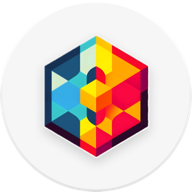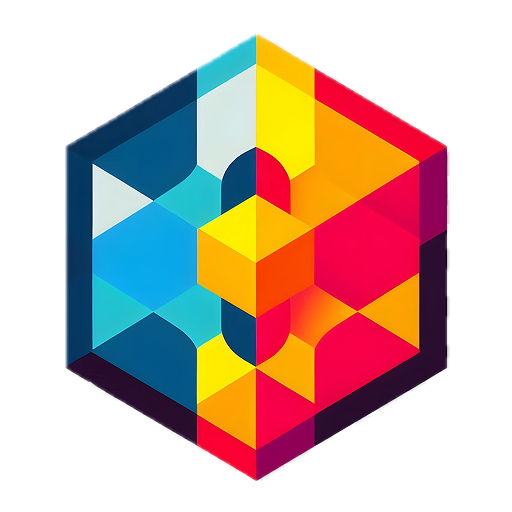The AI landscape has undergone a profound transformation in recent years, with multi-agent systems emerging as one of the most significant developments. As we speed through the 2025 AI freeway, these systems have moved beyond experimental labs to become mainstream solutions across industries.
According to recent industry surveys, multi-agent systems have been quickly working their way into many organizations using AI, highlighting their critical role in modern AI infrastructure.
Multi-agent systems represent a paradigm shift from traditional single-agent approaches.
Rather than relying on a single AI model to handle all aspects of a task, multi-agent systems distribute responsibilities among specialized agents, each focused on specific functions. This division of labor enables more complex reasoning, better task delegation, and ultimately more powerful applications.
The rise of frameworks like LangGraph and platforms like Flowise has democratized access to multi-agent architectures, allowing organizations of all sizes to implement sophisticated AI systems without extensive technical expertise.
With as many as 65% of enterprise AI applications now utilizing some form of multi-agent architecture, understanding how to build and deploy these systems has become an essential skill for AI practitioners.
This comprehensive guide will walk you through the process of creating dynamic multi-agent systems using Flowise and LangGraph, equipping you with the knowledge and tools to harness the full potential of this technology in 2025 and beyond.
Write your awesome label here.
Write your awesome label here.
Write your awesome label here.
Traditional single-agent systems rely on one LLM to handle all aspects of a task, or a group of tasks.
While this approach works for simple and smaller use cases, it quickly reaches limitations when dealing with complex workflows that require diverse skills and knowledge domains.
Single agents often struggle with:
- Context overload: Attempting to process and retain large amounts of information simultaneously
- Skill generalization: Being forced to be "jack of all trades, master of none"
- Error propagation: Mistakes in one part of the reasoning process affect all subsequent steps
- Scalability challenges: Difficulty handling increasingly complex tasks
Multi-Agent Systems: A Collaborative Approach
Multi-agent systems address these limitations by breaking down complex workflows into specialized roles, allowing for more sophisticated reasoning and better task delegation.
Key advantages include:
- Specialization: Each agent focuses on what it does best, resulting in 43% better performance compared to general-purpose agents
- Reduced error rates: Supervisor-worker architectures have demonstrated a 37% reduction in errors compared to single-agent systems
- Parallel processing: Multiple agents can work simultaneously on different aspects of a problem
- Modularity: Easier to update, maintain, and expand system capabilities
- Robustness: If one agent fails, others can compensate, creating more resilient systems
The ROI Advantage
The business case for multi-agent systems has become increasingly compelling. Companies implementing multi-agent architectures report a 3.5x return on investment compared to single-agent solutions.
This significant ROI stems from improved accuracy, enhanced capabilities, and the ability to tackle more complex use cases that were previously beyond the reach of AI systems

LangGraph has emerged as one of the dominant
Agentic Frameworks for orchestrating complex AI workflows in 2025.
Its graph-based approach to agent coordination provides a powerful and flexible foundation for building sophisticated multi-agent systems.
Core Components of LangGraph
- Nodes: Represent individual agents or functions within the workflow
- Edges: Define the relationships and data flow between nodes
- State: Manages persistent data across execution cycles
- Cyclic Graphs: Allow for iterative processes and feedback loops
- Conditional Routing: Enables dynamic workflow adjustments based on intermediate results
The Supervisor-Worker Model in LangGraph
LangGraph excels at implementing the supervisor-worker architecture, which has become the standard pattern for
multi-agent systems in 2025. In this model:
- Supervisor Agent: Orchestrates the workflow, delegates tasks, and aggregates results
- Worker Agents: Specialized agents that handle specific tasks within the workflow
- Message Passing: Facilitates communication between agents through a structured protocol
- State Management: One of LangGraph's key strengths is its robust state management capabilities.
The framework has many batteries included and provides built-in support for maintaining context across different nodes and enables features like:
- Pausing and resuming workflows
- Checkpointing for long-running processes
- Memory persistence across different executions
- Human-in-the-loop interventions
This state management is crucial for complex multi-agent systems where context needs to be preserved across multiple interactions and processing steps.
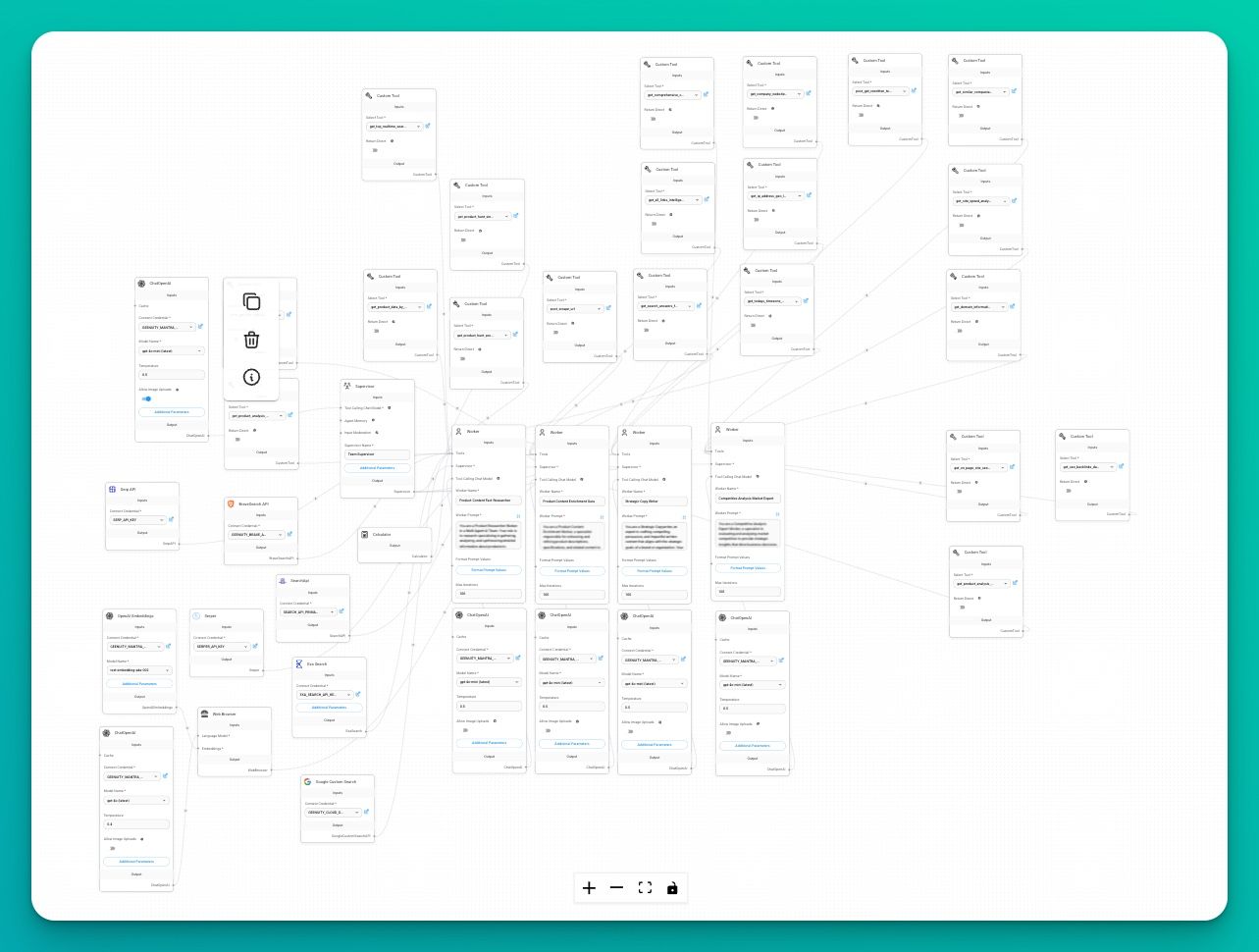
Flowise has integrated LangGraph as its primary multi-agent orchestration framework, providing a user-friendly interface for building complex AI systems without extensive coding.
Let's walk through the process of implementing a multi-agent system in Flowise.
Empty space, drag to resize
-
Search for "Supervisor Agent" in the nodes panel
-
Drag and drop it onto the canvas
-
Configure the base settings (LLM model, temperature, etc.)
-
In the Supervisor Agent configuration, add the names of your worker agents (e.g., "Researcher", "Writer", "Critic")
-
Set the recursion limit to prevent infinite loops (typically 10-15 is sufficient)
-
Make sure to connect all of the cables to the right inputs and outputs
-
For each worker in your team, add a corresponding Worker Agent node
-
Configure each worker with appropriate tools and settings based on their role
-
Verify that all connections are routed correctly
-
Connect the user input to the Supervisor Agent
-
Connect the Supervisor Agent to each Worker Agent
-
Connect each Worker Agent back to the Supervisor Agent
You are a supervisor tasked with managing a conversation between the following workers: {team_members}.
Given the user request, respond with the worker to act next. Each worker will perform a task and respond with their results.
When the task is complete, respond with FINISH.
-
For each worker, define a specific prompt that outlines their role, responsibilities, and how they should process information
-
Ensure each worker has access to the appropriate tools for their role
-
Specialized Role Definition: Clearly define each worker's area of expertise and limitations
-
Input/Output Format: Specify how the worker should process inputs and format outputs
-
Contextual Awareness: Ensure workers understand their place in the larger workflow
-
Supervisors: Lower temperature (0.1-0.3) for consistent, logical task delegation
-
Researchers/Analysts: Low temperature (0.0-0.2) for factual accuracy
-
Writers/Creators: Medium temperature (0.4-0.7) for creativity while maintaining coherence
-
Brainstormers/Ideators: Higher temperature (0.7-0.9) for maximum creativity
You can run your Multi-Agent Teams in free variable mode or setup dynamic variable templates. Allowing the supervisor and workers to figure things out on their own is powerful and works well in many cases, but if you are setting up very specialized and deterministic type of Agents, then you can utilize Flowise Variable Schemas.
Effective variable management is crucial for complex multi-agent systems. Here's how to implement it in Flowise:
Setting Up Schema for Dynamic VariablesCreate a Variable Schema:
Define the structure of data that will be passed between agents
Include all potential fields that might be needed throughout the workflow
Example Schema:
"company_name": "string",
"target_audience":
"demographics": "string",
"pain_points": "string",
"preferences": "string"
"keywords": ["string"],
"marketing_copy": "string",
"video_script": "string",
"email_template": "string"
Initialize Variables:
- Set up initial values for variables that are known at the start
- Leave placeholders for variables that will be populated during execution
Variable Passing Between Agents:
- Configure how variables are passed from the supervisor to workers
- Set up mechanisms for workers to update the shared state
Naming Conventions and Organization
Maintaining consistent naming conventions has proven critical for complex multi-agent systems. One effective approach in 2025 is:
- Prefix with Agent Type: e.g., supervisor_, researcher_, writer_. Use Descriptive Names: Avoid abbreviations and be explicit about the variable's purpose
- Versioning for Iterations: Include version numbers for variables that might be refined multiple times (e.g., marketing_copy_v1, marketing_copy_v2)
The true power of multi-agent systems comes from their integration with external applications. Here's how to connect your Flowise multi-agent system to production environments:
Setting Up API Endpoints
Everything you make in Flowise is an instant, production ready API Endpoint. You can configure many common API Settings in Flowise:
- Navigate to the "API" tab in your canvas
- Set up authentication
- Configure rate limiting and other security features
Integrating with Bubble.io and any other API Enabled Interface
Bubble.io has emerged as a popular no-code platform for building applications that leverage AI. Here's how to connect your multi-agent system:
Set Up API Connector in Bubble:
- Create a new API connector pointing to your Flowise endpoint
- Configure authentication using your API key
- Set up the data structure for requests and responses
Create Workflow Actions:
- Build workflows that trigger your multi-agent system
- Configure input mapping from your Bubble app to the API
- Set up response handling to process the multi-agent output
Implement Error Handling:
- Create contingency workflows for API failures
- Set up retry logic and fallback options
- Implement user feedback mechanisms for processing status
Real-time vs. Asynchronous Processing
For complex multi-agent workflows, choosing between real-time and asynchronous processing is critical:
- Real-time Processing: Suitable for simpler workflows where response time is critical (< 30 seconds)
- Asynchronous Processing: Better for complex workflows that may take longer to complete
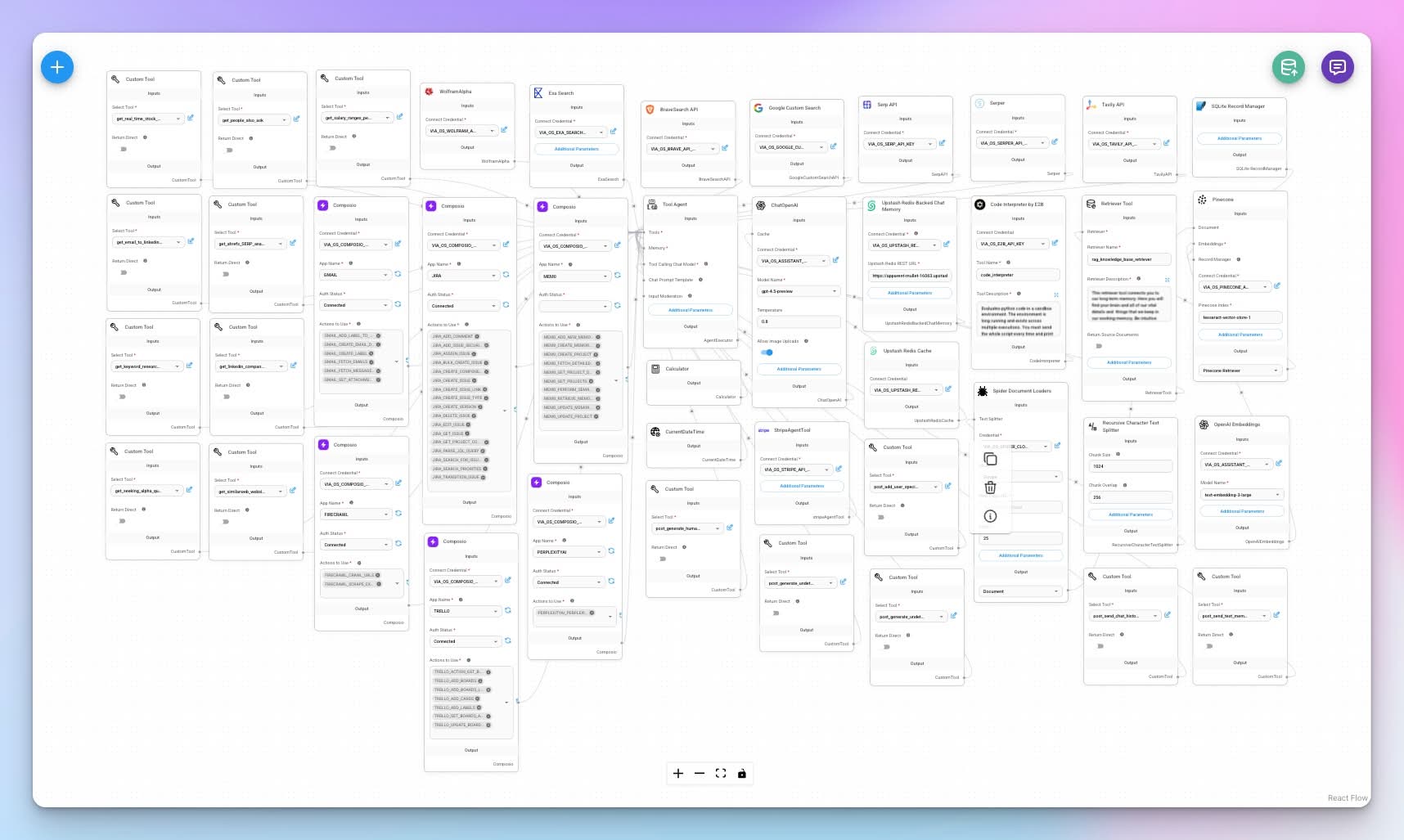
2025 has seen the rise of specialized agent marketplaces where organizations can discover, evaluate, and integrate pre-trained agents into their existing systems. These marketplaces offer agents with domain-specific expertise, ranging from legal analysis to medical diagnostics, financial forecasting to creative content generation.
The Tesseract Vault is at the forefront of this movement, offering over 400 production-ready templates that can be deployed in minutes rather than months. This approach has dramatically reduced implementation time by 87% compared to building custom agents from scratch.
While current multi-agent systems primarily work with text, the integration of multi-modal capabilities is rapidly advancing. Next-generation systems incorporate:
Visual Analysis Agents: Process and interpret images and video
Audio Processing Agents: Handle speech, music, and environmental sounds
Sensor Data Agents: Interpret IoT and sensor inputs for physical-world awareness
Organizations implementing multi-modal agent systems report a 53% increase in use case coverage compared to text-only systems.
Perhaps the most exciting development is the evolution toward true human-AI collaborative teams, where human specialists work alongside AI agents as equal team members. These hybrid teams leverage the complementary strengths of human intuition and creativity with AI's processing power and consistency.
Early adopters of this approach have reported:
76% increase in innovation output
42% improvement in decision quality
58% reduction in time-to-solution for complex problems
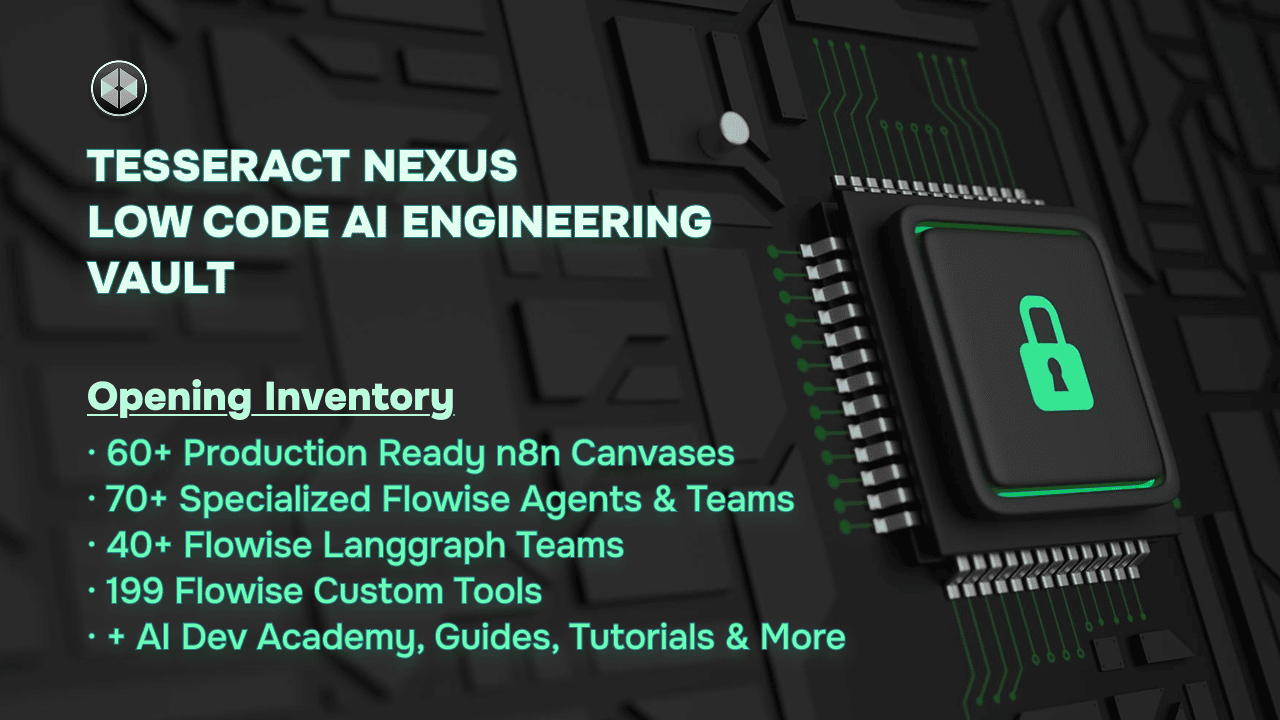
As we've explored throughout this guide, multi-agent systems represent a paradigm shift in AI implementation. By breaking complex tasks into specialized roles and orchestrating collaboration between agents, these systems achieve capabilities far beyond what single models can accomplish.
The key advantages of the multi-agent approach include:
-
Enhanced Problem-Solving: Specialized agents working together can tackle more complex problems
-
Improved Accuracy: Each agent focusing on its area of expertise leads to better results
-
Greater Flexibility: Modular design allows for easy updates and extensions
-
Scalability: Systems can grow to handle increasingly complex workflows
-
Reduced Costs: More efficient use of resources compared to monolithic approaches
As we move through 2025 and beyond, multi-agent systems will continue to evolve, becoming increasingly autonomous, capable, and integrated into our digital infrastructure. Organizations that master this approach will gain significant advantages in their AI implementations.
Whether you're just beginning your journey with multi-agent systems or looking to enhance existing implementations, the frameworks, techniques, and best practices outlined in this guide provide a solid foundation for success.
To continue your multi-agent system journey, explore these valuable resources:
-
Tesseract Vault: Access hundreds of production-ready automation templates, including numerous multi-agent systems
-
Tesseract Academy: Comprehensive courses on advanced AI implementation techniques
-
LangGraph Documentation: In-depth technical resources for the Lang Graph framework
-
Flowise Discord Community: Connect with other practitioners building multi-agent systems
The future of AI belongs to those who can effectively orchestrate collaboration between specialized agents. By mastering multi-agent systems today, you'll be well-positioned to lead in the AI landscape of tomorrow.





